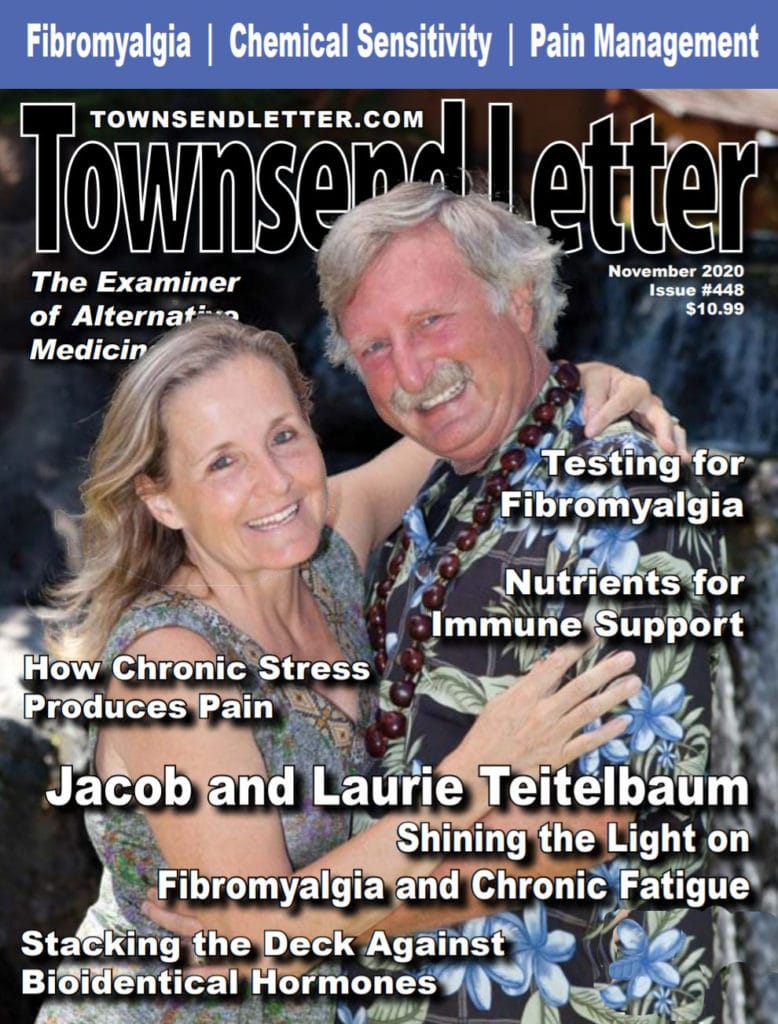…article continued:
Now go back and look at the symptoms of fibromyalgia, chronic fatigue, and MCS. The common features, the unifying factor, once you know all of the things the vagus does, is vagal dysfunction. But no one ever seems to think of it that way because there is no easy or risk-free way to treat the vagus. No one is going to install a vagal nerve stimulator because you have multiple chemical sensitivities, which they’re not even sure are real. No one is going to install a vagal nerve stimulator because you have a sore throat and swollen lymph glands from a chronic infection that they call chronic fatigue syndrome. And they don’t use vagal nerve stimulators for fibromyalgia even though 86% of fibromyalgia patients have irritable bowel and don’t digest their food well. It’s just too risky to install them and there are too many potential side effects, and it is really just easier to tell the patient to go on this diet, take these pills, and learn to live with it.
If you’re lucky and have the right skills, you can treat the trauma, resolve the mold, virus, dental or parasite infection and the patient is not inherently sensitized from some early childhood trauma and the hippocampus tells the vagus that the threat is gone and it is OK to come back on. The vagus comes back on and the patient recovers. If you and your patient are both lucky.
Case Report
The patient was a 49-year-old female who had fibromyalgia for 18 years following an auto accident. Her pain had been between 4/10 and 8/10 for 18 years. Her symptoms included headaches, burning midscapular pain, hand, arm, leg, foot, neck, back and jaw pain.22-28 Over the years she had developed asthma, allergies, acne and irritable bowel syndrome and had been diagnosed with digestive system candida overgrowth.
Fortunately, her body pain responded to the Frequency Specific Microcurrent treatment for fibromyalgia associated with spine trauma.29-30 When the pain decreased so that it was consistently below a 4/10, her digestion improved, her immune system quieted down, the allergies to food and environmental factors disappeared, the asthma resolved, her sleep improved and her fatigue resolved as her adrenal function and diurnal rhythm returned.31
She had twenty treatments between December 8 and March 15, and she used a home microcurrent unit as often as needed to keep her body pain below a 4/10 at all times. She had physical therapy to repair the pain generators in her neck and two sets of facet injections. She used one combination supplement for repairing her gut. Her acne and night vision cleared up when she was given an oil-based vitamin A supplement. No genetic testing was done, but it has been suggested that some patients can’t convert beta-carotene into the active form of vitamin A. By February 8, after eight weeks of treatment, she no longer met the diagnostic criteria for fibromyalgia. Her pain was consistently between a 2/10 and a 4/10 without medication. She slept well without medication and her irritable bowel syndrome resolved. By March 15 she was discharged from treatment and in June she moved to Colorado where her recovery was maintained for at least six years.
Think about all of the confusing, multi-system symptoms that were simply a result of body pain that remained between a 4/10 and 8/10 for 18 years. The body pain was eliminated by treating inflammation in the spinal cord, but the immune system activation, allergies and asthma were from the vagus.
Irritable bowel and candida. If your gut doesn’t move, and your pancreas continues to secrete bicarbonate, but your stomach doesn’t secrete as much acid as usual, your gut contents become alkaline and candida loves an alkaline environment. The friendly acid-loving bacteria don’t thrive, and they aren’t creating the short chain fatty acids and other products that repair your gut wall. The vagus. Again.
Sleep disruption resolved because the “tiger” was gone. The amygdala and hippocampus kept the threat response high because if the pain was a 7/10 there must be a “tiger.” When the pain was a 2-4/10, the tiger was gone, and sleep was welcome.
We were lucky because she had no early childhood trauma to maintain the sensitization and the vagus came back on by itself once the pain resolved. In 2000, when she was a patient, the vagal treatment had not yet been developed.
In 2020, the vagus can be treated with FSM and treating the vagus can improve the speed of response; but if the cause of vagal dysfunction is not corrected, the limbic system can turn the vagus off faster than it can be turned back on. Knowing how the vagus works and how it creates symptoms in so many body systems helps make sense of it all and makes the patient presentation less overwhelming.
If you look for the cause of the infection, stress, threat, pain or trauma and resolve that, and if you’re lucky, the limbic system will calm down and the vagus will come back on. If you need a little extra luck, Frequency Specific Microcurrent can give you a tool to help quiet the limbic system directly and turn the vagus back on.
References
- Yunus M, Masi AT, Calabro JJ, et al. “Primary Fibromyalgia (Fibrositis): Clinical Study of 50 Patients with Matched Normal Controls,” Seminars in Arthritis and Rheumatism. 1981; 11(1): 151-171.
- Bennett, RM. Adult growth hormone deficiency in patients with fibromyalgia, Curr Rheumatology 2002, Aug 4 (4) 306-12)
- Moldofsky H, Saskin P, and Salem L. “Sleep and Symptoms of Post-infectious Neuromyasthenia and Fibrositis Syndrome,” Sleep Research. 1997;16:492.
- Wolf F, Smythe HA, Yunus MB, et al. “Criteria for Fibromyalgia” Arthritis and Rheumatism. 1989;32(suppl.):S47.
- Crawford LJ. “Neuroendocrine Abnormalities in Fibromyalgia.” American Journal of the Medical Sciences. 1998; 315(6): 359-366.
- Crawford LJ, Engleberg NC, and Demitrack MA. “Neurohormonal Perturbations in Fibromyalgia.” Rheumatic Disease Clinics of North America. 1996; 22(2): 267-284.
- Crawford LJ, Pillemer SR, Kalogeras KT, et al. “Hypothalamic-Pituitary-Adrenal Axis Perturbations in Patients with Fibromyalgia.” Arthritis and Rheumatism. 1994; 37(11):1583-1592.
- Neeck G and Riedel W. “Hormonal Perturbations in Fibromyalgia Syndrome.” Annals of the New York Academy of Sciences. 1999; 876: 325-338.
- Maes M, et al, Serotonergic markers and lowered plasma branched-chain-amino acid concentrations in fibromyalgia, Psychiatry Research, vol 97, issue 1, Dec 2000, pp11-20.
- Dessein PH, Shipton EA, Stanwix AE, et al. “Hyposecretion of Adrenal Androgens and the Relation of Serum Adrenal Steroids, Serotonin ***” Pain. 1999; 83(2): 313-319.
- Dessein PH, Shipton EA, Stanwix AE, et al. “Neuroendocrine Deficiency-Mediated Development and Persistence of Pain in Fibromyalgia.” Pain. 2000; 86(3): 213-215.
- Juhl J, Fibromyalgia and the serotonin Pathway, Alternative Medicine Review, Vol. 3, Number 5, 1998
- McMakin C. Fibromyalgia: An Alternative View. Austin Rheumatology, October 2018
- Fibromyalgia Network: Newsletter for Fibromyalgia Syndrome/Chronic Fatigue Syndrome Patients. July 1994.
- Kroenke K, Wood DO, Mangelsdorff AD, et al, Chronic fatigue in primary care. Prevalence, patient characteristics, and outcome. JAMA. 1988; 260: 929-934
- Holmes GP, Kaplan JE , Gantz NM et al. Chronic fatigue syndrome: a working case definition. Ann Intern Med. 1988; 108: 387-389
- Jones JF, Ray CG, Minnich LL, et al, Evidence for active Epstein-Barr virus infection in patients with persistent, unexplained illnesses: elevated antiearly antigen antibodies., Ann Intern Med. 1985; 102: 1-7
- Graveling RA, Pilkington A, George, J, et al, A review of multiple chemical sensitivity, Occup Environ Med, 1999; 56: 73-85
- Kandel E, Schwartz J: Principles of Neural Science, second edition. Elsevier Science Publishing Co., Inc., New York, 1985: pp. 331-336
- Carter R, The Human Brain Book, 2nd Edition, DK, London, New York, 2014
- Tracey, K. J. (2007). Physiology and immunology of the cholinergic anti-inflammatory pathway. Journal of Clinical Investigation, 117(2), 289–296
- Cloward RB: Cervical discography: Mechanisms of neck, shoulder and arm pain. Annals of Surgery 150: 1052 – 1064, 1959
- Busklla D, Neuman L, Valsberg G, Alkalay D, Wolfe F.: Increased rates of fibromyalgia following cervical spine injury: a controlled study of 161 cases of traumatic injury. Arthritis and Rheumatism; 40: 446-452, 1997
- Bogduk N: The innervation of the cervical intervertebral discs. SPINE 13: 2-8, 1988
- Olmarker K, Blomquist J, Stromberg J, et al. “Inflammatogenic properties of nucleus pulposus.” SPINE. 1995; 20: 665-669.
- Olmarker K, Rydevik B, Nordberg C. “Autologous nucleus pulposus induces neurophysiologic and histologic changes in porcine cauda equina nerve roots.” SPINE. 1993; 18: 1425-32.
- Ozaktay AC, Cavanaugh JM, Blagoev DC. “Phospholipase A2 – induced electrophysiologic and histologic changes in rabbit dorsal lumbar spine tissues.” SPINE. 1995; 20: 2659-68.
- Ozaktay AC, Kallakuri S, Cavanaugh JM. “Phospholipase A2 sensitivity of the dorsal root and dorsal root ganglion.” SPINE. 1998; 23(12): 1297-1306.
- Cytokine changes with microcurrent therapy of fibromyalgia associated with cervical trauma.” McMakin C, Gregory W, Phillips T, Journal of Bodywork and Movement Therapies, July 2005, 9 169-176
- Microcurrent therapy in the treatment of Fibromyalgia”; Fibromyalgia Syndrome: A practitioners Guide to Treatment, 3nd Edition, Leon Chaitow, Elsevier Science Press, Edinburgh, 2008
- Moldofsky H. “Rheumatic Pain Modulation Syndrome: The Interrelationship Between Sleep, Central Nervous System Serotonin, and Pain.” Advancements in Neurology. 1982; 33:51-57.









